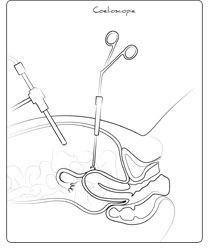Breast surgery
Adnexa surgery
Uterine surgery
Cervical surgery
Vulvar surgery
Other
Laparoscopy
Indications
Laparoscopy is a surgery used to look at the abdomen organs and the female pelvic organs – especially genital organs – without large incision of the belly.
Laparoscopy is performed for 2 main issues:
Diagnosis
Laparoscopy is done to check damages undetectable with other exploration mean, e.g. pelvic inflammatory disease sequela or endometriosis both entailing pelvic pain and/or infertility.
A dye test is realized to check permeability of Fallopian tubes: a colored dye (methylene blue) is injected through the cervix. If the tubes are not blocked the dye should pass along them and spill into the abdomen.
Therapeutic

This procedure is performed for:
- Ovarian drilling
- Adherences release
- Ovarian cystectomy
- Fimbrioplasty, neosalpingostomy
- PID treatment (Pelvic Inflammatory Disease)
- Tubal ligation (with clamps)
- Partial or complete hysterectomy
- Myomectomy
- Lymphadenectomy
- Prolapses’ cure
Procedure
General anesthesia is generally performed. A urinary tract catheter is installed through your urethra into the bladder to drain urines.
A cannula can be installed through your vagina into the uterus. It will allow your surgeon to move your uterus and get a better look when needed.
A small incision is made in the belly button. More than one incision may be made if other tools need to be used during surgery (on the lower part of your belly).
First incision is used to put a needle and gas is slowly put to inflate the belly. The gas lifts the abdominal wall from the organs.
A thin, lighted tube (laparoscope) is then put through the incision to look at the organs.
Other trocars will allow insertion of surgical instruments (graspers, scissors, coagulation material or washing material) to perform surgery.
Risks and complications
In spite of the meticulous surgery technics, it is not possible to guarantee neither therapeutic success nor a total absence of any complications.
During the intervention
- Abdominal opening: the access incision can be modified (“laparoconversion”) according to the observations made during the surgery, or if any per-operational complications occurred.
- Significant blood loss: may rarely lead to a blood transfusion
- Lesions of an organ nearby the uterus: this can exceptionally occur: intestinal, urinary tracts or blood vessels wounds, requiring a specific surgical assumption.
- Gas embolism: is the presence of gas bubbles into the bloodstream that obstruct circulation. This is extremely rare.
Post-operation
- Blood tumor or abscess in the abdominal wall: it generally requires local care, but a surgical evacuation may be an option.
- Lower extremity deep venous thrombosis and pulmonary embolism: in order to prevent this kind of complication, an early rising is recommended, as well as wearing support stockings and daily injections of anticoagulant.
- Gas pains into your shoulders: this is due to the gas injected into your belly for laparoscopy. Antalgic medicine will be given to you. In this case you better stay laid down, on your back, than seated.
Last update: 10/2/2013
